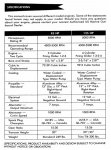SS Mud Bay Minnow
Recruit
- Joined
- Sep 10, 2014
- Messages
- 5
My 1985 Force 85 3-cylinder Chrysler engine is on a Bayliner Capri 1600. It seems to start and run fine, but will only push the boat about 10-12 knots and never gets up on a plane. Other people say their Force 85 will drive there Capri 1600 in the range of 35-40 mph. This is with a load of about 500 lbs of people and equipment.
I tested the compression, and it is an even 95 psi in all 3 cylinders. I notice that Force engines seem to have compression of 120-140 in other posts here, 140 being new-from-the-factory.
The guy I got it from is a boat mechanic, and he had taken the boat in on trade for some work he was doing. He told me he cleaned the carbs (3 of them) and that was it, it ran.
I already replaced the fuel line and secured it properly at the engine and the external tank.It had been leaking at the fuel tank quick connect. I clamped down the hose on the engine too. I put in new plugs, Champion QL-82C's. It previously had some Autolites with a round electrode.
Supposedly the gas it was running on, in a tank from the owner, was premixed correctly, so I haven't
What are some diagnostic steps I can do to figure out why the engine is such a dog and then fix the issue?
I tested the compression, and it is an even 95 psi in all 3 cylinders. I notice that Force engines seem to have compression of 120-140 in other posts here, 140 being new-from-the-factory.
The guy I got it from is a boat mechanic, and he had taken the boat in on trade for some work he was doing. He told me he cleaned the carbs (3 of them) and that was it, it ran.
I already replaced the fuel line and secured it properly at the engine and the external tank.It had been leaking at the fuel tank quick connect. I clamped down the hose on the engine too. I put in new plugs, Champion QL-82C's. It previously had some Autolites with a round electrode.
Supposedly the gas it was running on, in a tank from the owner, was premixed correctly, so I haven't
What are some diagnostic steps I can do to figure out why the engine is such a dog and then fix the issue?





















